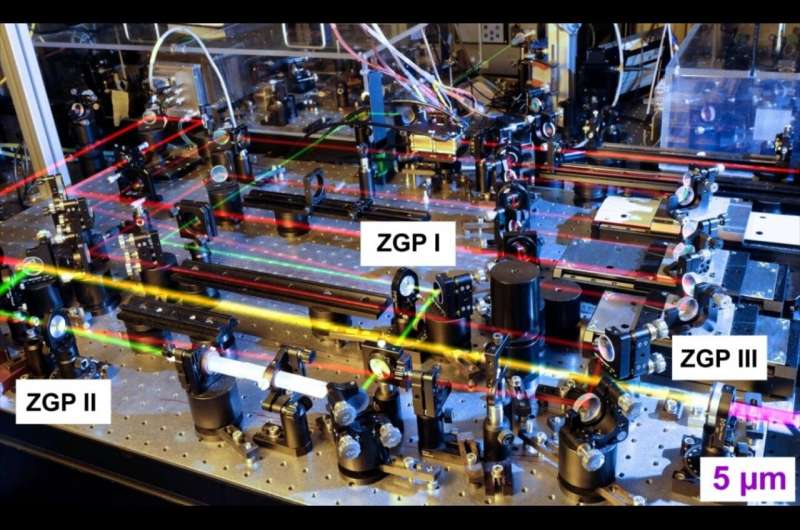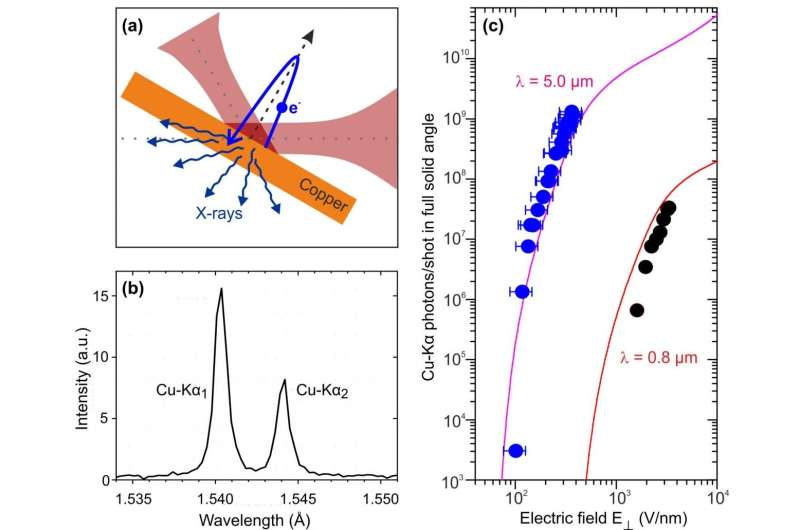High-flux table-top source for femtosecond hard X-ray pulses

Femtosecond hard X-ray pulses are an important tool for unraveling structure changes of condensed matter on atomic length and time scales. A novel laser-driven X-ray source provides femtosecond copper Kα pulses at a 1 kHz repetition rate with an unprecedented flux of some 1012 X-ray photons per second.
Elementary processes in physics, chemistry, and biology are connected with changes of the atomic or molecular structure on a femtosecond time scale (1 femtosecond (fs) = 10-15 seconds). Ultrafast X-ray methods hold strong potential for following structure changes in space and time and generate 'movies' of the motions of electrons, atoms and molecules. This perspective has resulted in a strong demand for femtosecond hard X-ray pulses to be applied in X-ray scattering and spectroscopy.
There are two main approaches to generate ultrashort hard X-ray pulses. The first are sources based on large-scale electron accelerators and undulators in which femtosecond electron bunches radiate bright X-ray pulses. The second are small-frame laboratory sources driven by intense femtosecond optical lasers. Here, electron acceleration occurs in the strong electric field of an optical pulse and X-ray pulses are generated by collisional interaction of such electrons with atoms of a metal target, similar to a conventional X-ray tube.

Researchers at the Max Born Institute (MBI) in Berlin have now accomplished a breakthrough in table-top generation of femtosecond X-ray pulses by demonstrating a stable pulse train at kilohertz repetition rate with a total flux of some 1012 X-ray photons per second. As they report in Optics Letters, the combination of a novel optical driver providing femtosecond mid-infrared pulses around a 5 μm (5000 nm) wavelength with a metallic tape target in a transmission geometry allows for generating hard X-ray pulses at a wavelength of 0.154 nm with very high efficiency.
The optical driver is based on optical parametric chirped pulse amplification (OPCPA) and provides 80-fs pulses at a central wavelength of 5 μm with an energy of 3 mJ and a repetition rate of 1 kHz. To generate X-ray pulses, the mid-infrared pulses are tightly focused onto a thin copper target (Fig 1). In an optical cycle of the optical field, electrons are extracted from the copper tape, accelerated in vacuum and steered back to the target. Electrons with a kinetic energy of up to 100 keV reenter the target and generate bright copper Kα pulses at a wavelength of 0.154 nm, accompanied by spectrally broad bremsstrahlung. The longer optical cycle of the mid-infrared pulses compared to pulses at shorter optical wavelengths results in longer acceleration times of the electrons, higher kinetic energies, and eventually higher efficiency in X-ray generation (Fig. 2).
The new table-top X-ray source reaches an average number of Cu-Kα photons up to 1.5x109 photons per pulse in the full solid angle or 1.5x1012 photons per second (blue dots in Fig 2c). This photon flux is 30 times higher than from commonly used table-top X-ray sources driven by Ti:sapphire lasers at the central wavelength of 0.8 μm (black dots in Fig 2c). Such source parameters open exciting perspectives for investigating ultrafast structure changes in condensed matter by time-resolved X-ray scattering.
More information: Azıze Koç et al, Compact high-flux hard X-ray source driven by femtosecond mid-infrared pulses at a 1 kHz repetition rate, Optics Letters (2020). DOI: 10.1364/OL.409522
Journal information: Optics Letters
Provided by Max Born Institute for Nonlinear Optics and Short Pulse Spectroscopy (MBI)




















